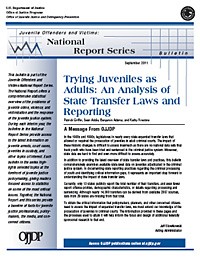On June 25, 2012, the U.S. Supreme Court ruled that state laws that mandatorily sentence juveniles convicted of homicide to life in prison without parole are unconstitutional. Life without parole for juveniles violates the Eighth Amendment's prohibition on cruel and unusual punishment, the High Court ruled in a 5–4 decision. The ruling could affect nearly 2,500 juveniles currently incarcerated in adult prisons.
Delivering the opinion of the Court, Justice Elena Kagan wrote, "Mandatory life without parole for a juvenile precludes consideration of his chronological age and its hallmark features—among them, immaturity, impetuosity, and failure to appreciate risks and consequences. It prevents taking into account the family and home environment that surrounds him—and from which he cannot usually extricate himself—no matter how brutal or dysfunctional."
The Supreme Court ruled on two cases, Miller v. Alabama and Jackson v. Hobbs. Evan Miller and Kuntrell Jackson were both sentenced to life in prison for separate murders committed when they were 14 years old.
Miller, who had been in and out of foster care, had attempted suicide four times—the first when he was 6 years old. After using drugs and alcohol one night, Miller beat and killed a man during the course of a robbery.
In November 1999, Jackson accompanied two other boys to a video store to commit a robbery. On the way to the store, Jackson discovered that one of the boys was carrying a gun. At first, Jackson decided to stay outside. But he later entered the store, when one of the boys shot and killed the store clerk.
The American Psychological Association lauded the ruling saying that "A consistent and growing body of social science and neuroscience research findings supports the conclusion that juveniles are less culpable than adults, and are entitled to different treatment in sentencing in light of their immaturity, vulnerability and changeability."

Trying Juveniles as Adults was one of three OJJDP publications cited in the Supreme Court's ruling.
The historic decision follows two other recent Supreme Court decisions that place stricter limits on sentencing for crimes involving juveniles. The High Court in 2010 declared juveniles found guilty of nonhomicides could not receive life without parole, and in 2005 the Court banned the death penalty for juveniles. All three decisions cited scientific evidence showing that adolescents' brains continue to develop and mature until sometime in their midtwenties and that judges must take this factor into account in sentencing decisions.
The recent Court decision cited three OJJDP publications developed under its National Juvenile Justice Data Analysis Program: Trying Juveniles as Adults: An Analysis of State Transfer Laws and Reporting (cited on p. 25 of the Court's decision), Juvenile Arrests 2009 (cited on p. 4 of Chief Justice Roberts' dissenting opinion), and Juvenile Offenders and Victims: 2006 National Report (cited on p. 24 of the Court's decision).
"This Supreme Court decision is an indicator of the significant progress we're making in juvenile justice," said Melodee Hanes, the Office's Acting Administrator. "It underscores the importance of bringing scientific findings and statistical analyses into national discussions about youth justice and safety."
Resources:
The Supreme Court ruling banning mandatory life without parole for juveniles convicted of homicide is available online.
To access more information and data about juveniles in court and other topics related to juvenile justice, visit the Web sites of the OJJDP-supported National Center for Juvenile Justice and OJJDP's Statistical Briefing Book.
OJJDP's National Center for Youth in Custody (NC4YC) provides training and technical assistance to a range of detention and correction facilities in which juveniles are placed, including adult facilities. To learn more about NC4YC, visit the center's Web site.
